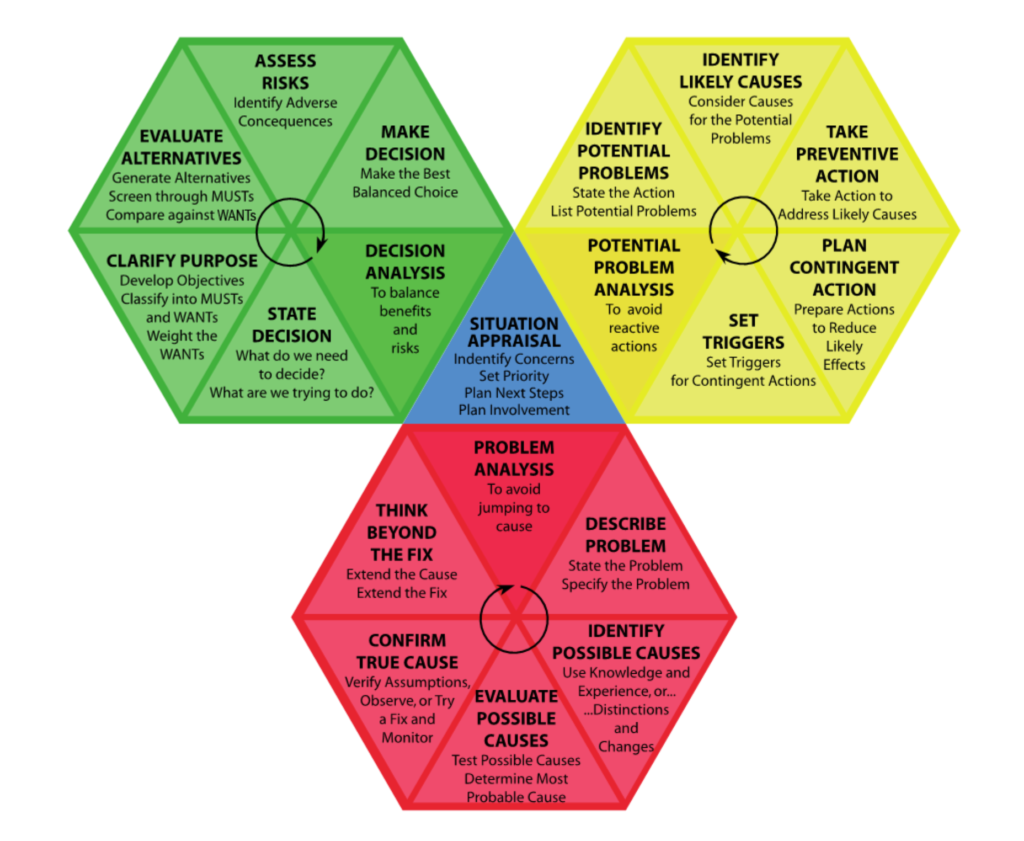The Kepner Tregoe Method, also known as the KT-method, developed by Charles Kepner and Benjamin Tregoe.
When we should use it?
The Kepner Tregoe method is a problem analysis model which fits well when the “problem” is disconnected from the “decision”.
The Kepner-Tregoe Matrix comprises 4 steps:
- Situation Appraisal – identify concerns and outline the priorities.
- Problem Analysis – describe the exact problem or issue by identifying and evaluating the causes.
- Decision Analysis – identify and evaluate alternatives by performing a risk analysis for each and then make a final decision.
- Potential Problem Analysis – evaluate the final decision for risk and identify the contingencies and preventive actions necessary to minimize that risk.

How to use it
- Prepare a decision statement.
This is a general overview of what the decision is expected to achieve (the key objective).
The statement should discuss the action that is required and the result that is desired. - Establish strategic requirements (“Must Haves”).
What “musts” will the final decision provide, allow for, include, etc.? For example: we must have 10 percent cost saving, we must include four color choices, the rope must hold 200 lbs.
These requirements are absolute – there is no compromise. - Establish operational objectives (“Want to Haves”).
What do you “want” the final decision to support?
By identifying the wants you can rank the alternatives according to which ones satisfy the most, or most important, wants. - Identify the restraints (Limits).
What are the things that will limit your ability to do exactly what you want/need?
These are typically resource constraints like money, materials, and time. - Rank the operational objectives and assign relative weights.
For each “want”, assign a rating of 1 – 10 based on the degree of importance.
- Generate a list of alternatives.
Think of as many alternative courses of action as you can. Don’t be too concerned that they all meet the “musts” and “wants” you just defined. You will rank these alternatives in the next step.
Brainstorming is a good approach for generating your list of alternatives. - Assign a relative score for each alternative.
First, eliminate any alternatives that do not meet the “musts” – these are not worth considering any further.
Second, go through each objective (want) and rate how well the alternative satisfies it using a 1 – 10 scale.
Third, multiply the weight of the objective by the satisfaction rating to come up with a weighted score for each objective.
Fourth, add the weighted scores to determine the total weighted score.
Repeat the process for each alternative.
- From the total weighted score for each alternative, rank the top two or three alternatives.
Remember to make sure that the alternatives you choose meet all the “must” criteria. - For the top alternatives, generate a list of potential problems (adverse effects) for each.
Rank the potential problems for each alternative according to probability and significance.
Obtain a total weighted score for the adverse effect (adversity rating).
- Analyze the alternative ranking and the adversity rating and make a final decision.
- Decide on mitigating actions for the chosen alternative.
Look at each of the adverse effects already identified and generate a list of proactive responses to reduce the probability of each.
Continuously monitor these probabilities and take action as needed.
